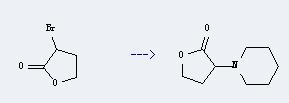-
Name
2-Bromo-4-butanolide
- EINECS 225-764-4
- CAS No. 5061-21-2
- Article Data22
- CAS DataBase
- Density 1.82 g/cm3
- Solubility
- Melting Point
- Formula C4H5BrO2
- Boiling Point 287.9 °C at 760 mmHg
- Molecular Weight 164.986
- Flash Point 111.5 °C
- Transport Information UN 2810
- Appearance pale yellow liquid
- Safety 26-36
- Risk Codes 36/37/38
-
Molecular Structure
-
Hazard Symbols
 Xi
Xi
- Synonyms Butyric acid, a-bromo-g-hydroxy-, g-lactone (4CI);2-Bromo-4-butyrolactone;2-Bromo-g-butyrolactone;Butyric acid, 2-bromo-4-hydroxy-, g-lactone (6CI,7CI);2(3H)-Furanone,3-bromodihydro-, (?à)-;3-Bromo-4,5-dihydrofuran-2-one;3-Bromodihydro-2(3H)-furanone;3-Bromodihydrofuran-2-one;3-Bromotetrahydrofuran-2-one;NSC 11726;NSC 56959;a-Bromo-g-butyrolactone;a-Bromobutyric acid g-lactone;3-Bromo-2-oxotetrahydrofuran;3-Bromo-4,5-dihydro-2(3H)-furanone;2-Bromo-4-hydroxybutyric acid γ-lactone;
- PSA 26.30000
- LogP 0.69680
2-Bromo-4-butanolide Specification
The 2-Bromo-4-butanolide, with the CAS registry number 5061-21-2 and EINECS registry number 225-764-4, has the systematic name of 3-bromodihydrofuran-2(3H)-one. And the molecular formula of this chemical is C4H5BrO2. It is a kind of pale yellow liquid, and belongs to the following product categories: Pharmaceutical Intermediates; Heterocycles; Miscellaneous Reagents. What's more, it is a lactams inhibit type Q arylesterase activity of human serum paraoxonase PON1, and it is also used as intermediate of pesticide and medicine.
The physical properties of 2-Bromo-4-butanolide are as following: (1)ACD/LogP: -0.47; (2)# of Rule of 5 Violations: 0; (3)ACD/LogD (pH 5.5): -0.47; (4)ACD/LogD (pH 7.4): -0.47; (5)ACD/BCF (pH 5.5): 1; (6)ACD/BCF (pH 7.4): 1; (7)ACD/KOC (pH 5.5): 13.15; (8)ACD/KOC (pH 7.4): 13.15; (9)#H bond acceptors: 2; (10)#H bond donors: 0; (11)#Freely Rotating Bonds: 0; (12)Polar Surface Area: 26.3 Å2; (13)Index of Refraction: 1.529; (14)Molar Refractivity: 27.96 cm3; (15)Molar Volume: 90.6 cm3; (16)Polarizability: 11.08×10-24cm3; (17)Surface Tension: 46.6 dyne/cm; (18)Density: 1.82 g/cm3; (19)Flash Point: 111.5 °C; (20)Enthalpy of Vaporization: 52.71 kJ/mol; (21)Boiling Point: 287.9 °C at 760 mmHg; (22)Vapour Pressure: 0.00242 mmHg at 25°C.
Uses of 2-Bromo-4-butanolide: It can be used to produce 3-piperidin-1-yl-dihydro-furan-2-one. This reaction will need solvent toluene. And the yield is about 48%.

You should be cautious while dealing with this chemical. It irritates eyes, respiratory system and skin, and it is also harmful if swallowed. Therefore, you had better take the following instructions: Wear suitable protective clothing, and in case of contacting with eyes, rinse immediately with plenty of water and seek medical advice.
You can still convert the following datas into molecular structure:
(1)SMILES: O=C1OCCC1Br
(2)InChI: InChI=1/C4H5BrO2/c5-3-1-2-7-4(3)6/h3H,1-2H2
(3)InChIKey: LFJJGHGXHXXDFT-UHFFFAOYAP
Related Products
- 2-Bromo-4-butanolide
- 506-13-8
- 50614-84-1
- 50615-18-4
- 50615-66-2
- 50621-08-4
- 506-21-8
- 50622-09-8
- 50623-73-9
- 506-24-1
- 50624-46-9
Hot Products
About|Contact|Cas|Product Name|Molecular|Country|Encyclopedia
Message|New Cas|MSDS|Service|Advertisement|CAS DataBase|Article Data|Manufacturers | Chemical Catalog
©2008 LookChem.com,License: ICP
NO.:Zhejiang16009103
complaints:service@lookchem.com Desktop View